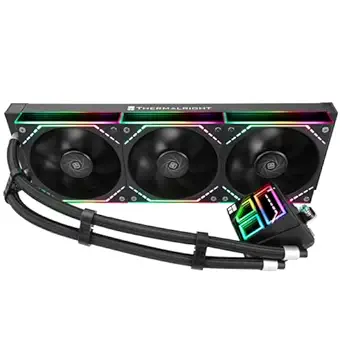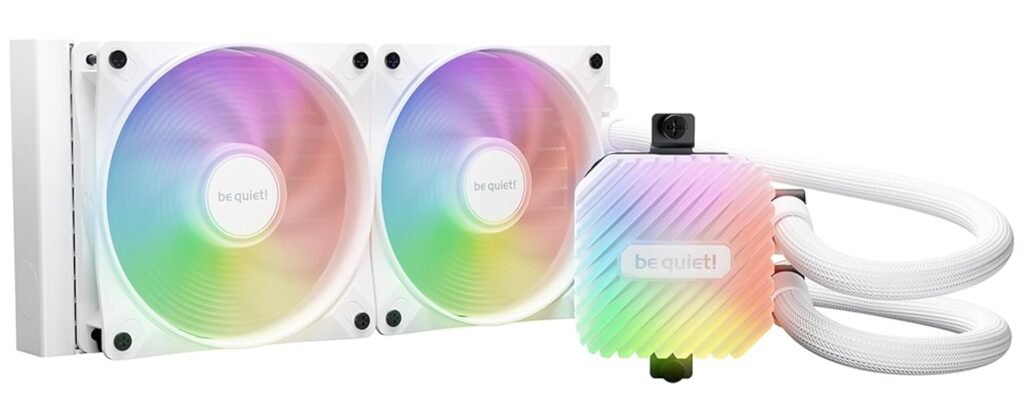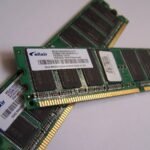An All-In-One (AIO) PC cooler is a liquid cooling system that keeps your computer’s central processing unit (CPU) cool and running smoothly. Unlike traditional fans that use air to cool down components, AIO coolers use liquid to transfer heat away from the CPU, which helps to prevent overheating and ensures your computer runs at its best performance.
Why AIO Coolers Are Important
PC components generate a lot of heat during use. If the temperature gets too high, it can cause the CPU or GPU to throttle (reduce performance) or even cause long-term damage. This is why cooling systems are necessary.
Here are some common reasons why AIO coolers are so important:
- Better Cooling Efficiency: AIO coolers are often more effective than traditional air cooling because liquid is better at moving heat away from the CPU.
- Quiet Operation: Since they don’t rely on large fans spinning at high speeds, AIO coolers tend to be quieter than air coolers.
- Space-Saving: AIO coolers are more compact than traditional cooling systems, which makes them ideal for smaller cases or builds that need to save space.
- Improved Performance: By keeping temperatures lower, AIO coolers help your PC perform better and for longer periods, especially under stress.
What Does AIO Stand for in PC Cooling?
The acronym AIO stands for All-In-One, which refers to a cooling system that combines all the necessary components to cool your CPU into one package. It’s a complete liquid cooling solution that typically includes a pump, radiator, tubing, and fans—all packed together in a single, easy-to-install unit.
In the case of AIO coolers, the “all-in-one” setup means you don’t have to worry about buying individual components, like a pump or radiator, separately. This makes AIO coolers popular because they save you time and effort in choosing compatible parts for your cooling setup. It’s like buying a ready-to-go system you can install and start using!
Why AIO?
The term “AIO” refers to cooling systems that integrate multiple elements into one system, as opposed to traditional cooling setups that often require you to purchase and install each part separately. With AIO coolers, everything is pre-built and tested, making them ideal for those who want an easy solution for keeping their CPU cool without the hassle of custom builds.
What’s in an AIO Cooling System?
An AIO cooler typically includes the following components:
- Pump: Moves the coolant around the system.
- Radiator: Dissipates the heat absorbed by the liquid.
- Tubing: Carries the coolant between the pump and radiator.
- Fans: Help cool the radiator by pushing air through it.
- Coolant: A liquid that absorbs and transfers heat away from the CPU.
All these parts come together in one package, making AIO coolers a convenient and effective solution for PC cooling.
Is It Really All-in-One?
Yes, AIO coolers are called “All-In-One” because they come with all the components needed for liquid cooling in one package. This includes:
- A radiator,
- Fans,
- A pump,
- Tubing, and sometimes even additional features like RGB lighting for aesthetics.
Everything is pre-assembled, which makes installation much easier compared to custom water-cooling loops, where each part has to be purchased and installed separately.
AIO vs. Traditional Cooling Systems
To give you a clearer idea of why AIO coolers are so popular, let’s compare them to traditional air cooling systems:
| Feature | AIO Coolers | Air Coolers |
| Cooling Efficiency | Higher, thanks to liquid cooling. | Lower, as air is less efficient at heat dissipation. |
| Noise Levels | Quieter, with efficient pump and fan design. | Often louder due to larger fans working at higher speeds. |
| Installation Complexity | Easy, as all components are pre-integrated. | Can be more complex with separate parts to install. |
| Space Requirement | Compact, ideal for small builds. | Larger, requiring more space for big air coolers. |
| Customization | Limited, as the system comes pre-built. | More customization options with separate parts. |
How Do AIO Coolers Work?
An All-In-One (AIO) cooler is designed to manage heat by using a liquid cooling system. Let’s break down how it works step by step:
- Coolant Circulation:
- The AIO cooler has a pump, usually located at the base of the cooler near the CPU. This pump circulates a special liquid coolant through the system.
- The coolant absorbs the heat from the CPU, carrying it away from the processor and into the radiator.
- Heat Dissipation via the Radiator:
- The radiator is typically mounted at the top or front of the case. Coolant travels through the radiator’s tubes, where it dissipates the heat collected from the CPU.
- The fans attached to the radiator blow air through the fins, helping cool the liquid coolant before it is sent back to the pump.
- Loop Cycle:
- The liquid coolant returns to the pump, where it picks up more heat from the CPU. The cycle continues as long as the system is running.
By using liquid coolant, AIO coolers can more efficiently transfer heat away from the CPU than air coolers, which rely on fans to blow air over the CPU’s heat sink.
How Do AIO Coolers Keep Your CPU Cool?
Here’s an overview of the key components of an AIO cooler and how they work together to keep your CPU cool:
| Component | Function |
| Pump | Circulates coolant throughout the system to remove heat from the CPU. |
| Radiator | Transfers heat from the coolant to the air through fans. |
| Fans | Pulls air through the radiator to cool the liquid inside. |
| Coolant | Absorbs and carries heat away from the CPU. |
| Tubing | Carries the coolant between the pump and the radiator. |

Advantages of AIO Cooling Over Air Cooling
AIO coolers provide superior cooling because liquid is far better than air at transferring heat. Here’s why liquid cooling in AIO systems works so well:
- Higher Heat Transfer Efficiency:
Liquid is more efficient than air at transferring heat. AIO coolers use liquid coolant, which moves heat away from the CPU quickly and easily. This is crucial for systems that perform demanding tasks, such as gaming or video rendering. - Consistent Cooling:
AIO coolers provide more stable and consistent cooling over long periods. Since the liquid continuously circulates, it can maintain lower temperatures for extended gaming or heavy software use. - Smaller Form Factor:
AIO coolers typically use compact radiators that fit into tighter spaces inside the PC case. This is beneficial if you have a small case or want to keep your PC clean and organized. - Less Noise:
AIO coolers are often quieter than air coolers because the fans on AIO systems don’t have to spin as fast. This makes them an excellent choice for users who prioritize noise reduction in their PC setup.
Types of AIO Coolers: Sizes and Configurations
When choosing an AIO cooler, one of the most important factors to consider is its size and configuration. Different sizes and configurations offer various benefits, depending on your PC build, available space, and cooling needs. In this section, we’ll explore the most common radiator sizes and fan configurations and how they affect performance.
Radiator Sizes of AIO Coolers
AIO coolers come in different radiator sizes. The radiator size determines how much heat the cooler can handle and how many fans it uses. Here’s an overview of the most popular radiator sizes and their typical use cases:
| Radiator Size | Common Fans | Best For |
| 120mm | 1 fan | Compact builds, low to mid-range CPUs, smaller cases. |
| 240mm | 2 fans | Mid-range builds, balanced cooling and performance. |
| 360mm | 3 fans | High-performance CPUs, gaming setups, overclocking. |
| 420mm | 3-4 fans | High-performance CPUs, gaming setups, and overclocking. |
Choosing the Right Radiator Size
- 120mm Radiator:
A 120mm radiator is the smallest and most compact AIO cooler. It’s a good choice for small PC cases or builds that don’t need heavy cooling. However, it may struggle to cool high-end CPUs or during long gaming sessions. - 240mm Radiator:
A 240mm radiator is often the sweet spot for mid-range builds. It offers a balance of cooling power and size, and it can handle most gaming CPUs and regular computing tasks without issue. - 360mm Radiator:
A 360mm radiator is ideal for gamers or PC enthusiasts who need superior cooling. It provides more surface area for the coolant to dissipate heat, making it perfect for high-performance processors or overclocked systems. However, this radiator requires a larger case. - 420mm Radiator:
The 420mm radiator is for extreme cooling setups. It’s perfect for highly overclocked CPUs or building a high-end gaming rig that requires maximum cooling. The larger size offers excellent heat dissipation but requires a spacious case.
Fan Configurations for AIO Coolers
In addition to radiator size, the fan configuration (how many fans are included and how they are positioned) also affects cooling performance. AIO coolers typically come with 1 to 3 fans, but several configurations affect airflow and noise.
- Single Fan (1x 120mm or 1x 140mm):
Single-fan AIO coolers are typically paired with a 120mm radiator. They are compact, take up less space, and are often used for low-power builds or small form-factor cases. However, they may struggle to cool high-performance CPUs under heavy load. - Dual Fan (2x 120mm or 2x 140mm):
The most common AIO coolers are dual-fan models. These provide better cooling than single-fan models and are suitable for most gaming or productivity PCs. They offer a good balance between performance and size. - Triple Fan (3x 120mm or 3x 140mm):
Triple fan AIO coolers are for serious gamers or enthusiasts who need the best cooling. They are typically paired with 240mm or 360mm radiators and provide top-tier heat dissipation. However, these require larger cases to fit comfortably.
Choosing the Right Fan Configuration
When choosing the fan configuration, it’s important to consider both the size of your case and your cooling needs:
- Small Cases: If you’re building a PC in a smaller case, you might only have space for a single fan or a dual-fan radiator. Make sure your case supports the size of the cooler you want to install.
- Balanced Performance: For most users, a 240mm radiator with dual fans provides a good balance of cooling and space, and it can handle gaming CPUs and moderate overclocking.
- High-End Performance: For heavy overclocking, extreme gaming, or workstation tasks, a 360mm or 420mm radiator with three or more fans will give you the best cooling performance, but be sure your case has enough space for these larger coolers.
How Size and Configuration Affect Cooling Performance
The size of the radiator and the number of fans directly impact the cooling efficiency of an AIO cooler. A larger radiator and more fans allow the cooler to handle higher amounts of heat, making them ideal for high-performance CPUs and demanding tasks. However, it’s important to match your cooler with your case size and cooling needs to ensure optimal performance and fit.
- Larger radiators (360mm and 420mm) provide better cooling but may be overkill for standard gaming or office tasks.
- Smaller radiators (like 120mm) are good for less demanding setups but may not provide enough cooling for heavy workloads.

AIO Cooler Benefits
In conclusion, AIO coolers offer several benefits over traditional air coolers:
- Better cooling performance thanks to the use of liquid coolant.
- Compact, space-saving design ideal for smaller cases or tidy builds.
- Lower noise levels compared to larger air coolers with high-speed fans.
- Aesthetic appeal with customizable RGB lighting and sleek designs.
- Improved overclocking potential by efficiently handling higher heat loads.
- Easy installation and low maintenance, making them ideal for beginners and pros alike.
How to Choose the Right AIO Cooler
When choosing the right AIO cooler, make sure to consider:
- Compatibility with your PC case and CPU socket.
- Cooling performance based on your PC’s usage (light gaming, heavy gaming, or overclocking).
- Budget and features, balancing price with the features you need.
- Noise levels if quiet operation is important to you.
- Aesthetic preferences for RGB lighting and customizable displays.
- Warranty and brand reputation for reliable and long-lasting cooling.
Maintenance and Troubleshooting
Even though All-In-One (AIO) coolers are designed to be low-maintenance, regular upkeep can ensure that your cooling system runs at peak performance for a long time. Proper maintenance and regular checks can extend the life of your AIO cooler and ensure it’s continually operating efficiently. Regular cleaning, checking for leaks, and monitoring pump and fan performance are crucial. If you encounter common issues like high temperatures, noise, or leaks, following the troubleshooting steps above will help you address the problem. In cases of persistent issues, replacing the cooler may be the best solution.
Comparing AIO Coolers: Top Picks and Reviews
When it comes to selecting an All-In-One (AIO) cooler, several models are available, each with unique features, cooling capabilities, and price points. Below, we review some top-performing AIO coolers, highlighting their strengths and any potential considerations to help you choose the best option for your build.
1. Thermalright Grand Vision 360
- Radiator Size: 360mm
- Fans: Three 120mm fans
- Key Features: The Thermalright Grand Vision 360 offers exceptional cooling performance, especially in high-demand tasks like gaming and overclocking. It features an LCD screen that can display customizable presets or even CPU temperatures, adding both function and flair to your build. This cooler is a strong contender in terms of performance and design.
- Considerations: While the cooler performs exceptionally well, it can get a bit noisy under full load, especially during heavy gaming or rendering tasks. Additionally, the cable management could be improved for easier installation.
2. Cooler Master MasterLiquid 360 Atmos
- Radiator Size: 360mm
- Fans: Three 120mm fans
- Key Features: The Cooler Master MasterLiquid 360 Atmos is an excellent choice for those who value both aesthetics and performance. It provides solid cooling efficiency and operates relatively quietly under typical usage. The cooler’s sleek design and premium features make it a solid option for gamers and content creators.
- Considerations: Noise levels can vary at full fan speeds, which might concern users seeking the quietest possible operation. Additionally, it is slightly more expensive than other models in its category.
3. ID-Cooling FX360 INF
- Radiator Size: 360mm
- Fans: Three 120mm fans
- Key Features: The ID-Cooling FX360 INF is an affordable option with impressive thermal performance. It performs almost on par with higher-end coolers while being much more budget-friendly. Its low noise levels and good value for money make it an attractive choice for users on a tighter budget.
- Considerations: This cooler lacks some of the advanced features found in pricier models, such as LCD screens or extensive RGB lighting options. However, if you’re looking for great cooling at a lower cost, this is a solid option.
4. Lian Li Galahad II LCD 280
- Radiator Size: 280mm
- Fans: Three 120mm fans
- Key Features: The Lian Li Galahad II LCD 280 stands out due to its vibrant RGB lighting and LCD display, which can show real-time CPU temperatures, pump speed, or other performance data. In addition to its aesthetic appeal, it offers high-end cooling performance with minimal noise.
- Considerations: The larger radiator size may not fit in smaller cases, so it’s important to verify your case’s compatibility before purchasing. Additionally, the cooler’s price is higher due to its premium features.
5. Be Quiet! Light Loop
- Radiator Sizes: Available in 240mm and 360mm
- Fans: Two 120mm fans
- Key Features: As the name suggests, Be Quiet! Light Loop is designed to provide silent cooling without compromising performance. Its exceptionally quiet pump and well-designed fans make it ideal for users who prioritize a silent PC build. It also features RGB lighting, adding a visual appeal without making the PC louder.
- Considerations: Installation can be slightly complex for some users, especially those who are new to building PCs. It requires careful setup to ensure the cooler performs as efficiently as possible.

6. Arctic Liquid Freezer III A-RGB
- Radiator Sizes: 240mm, 280mm, 360mm, and 420mm
- Fans: High-quality 120mm or 140mm fans
- Key Features: The Arctic Liquid Freezer III A-RGB is one of the top performers in the AIO cooler market. It stands out due to its outstanding cooling efficiency, often surpassing competitors in thermal benchmarks. The cooler includes an additional fan that helps cool the motherboard’s VRMs, improving overall system stability. The A-RGB lighting adds a customizable touch to the build, making it an attractive choice for users who like to personalize their PC’s look.
- Considerations: The thicker radiator may not fit in all cases, especially in smaller mid-tower builds. Additionally, this cooler has limited support for older Intel sockets (LGA115x), so users with older CPUs may need to look elsewhere.

Frequently Asked Questions (FAQs)
What is the difference between AIO and custom water cooling systems?
AIO coolers are pre-built, self-contained systems with a pump, radiator, tubing, and fans all in one package, making them easier to install. Custom water cooling systems, on the other hand, allow for more flexibility and customization but require careful assembly, maintenance, and greater technical expertise. AIOs are more beginner-friendly, while custom loops provide more control and cooling power for extreme use cases like heavy overclocking.
Can I install an AIO cooler myself, or should I seek professional help?
Yes, AIO coolers are designed for easy installation and are often user-friendly. Most models come with step-by-step instructions, and many manufacturers provide online guides or video tutorials. Unless you’re installing a very large cooler in a tight case or dealing with unique issues, you can typically install the cooler yourself without professional help.
How do I know if my PC case supports the radiator size of an AIO cooler?
To ensure compatibility, you should check your PC case specifications to see the maximum supported radiator size. Most cases list the maximum radiator length supported on the front, top, or rear of the case. You can measure the internal space in your case and compare it with the dimensions of the radiator to ensure a proper fit.
Are AIO coolers noisy during operation?
AIO coolers generally operate quieter than traditional air coolers because their fans don’t need to spin at such high speeds. However, noise levels can vary depending on the cooler’s fan speed, radiator size, and pump type. Some AIOs have built-in features to reduce noise levels, such as fan speed controllers or silent pump designs. If quiet operation is important to you, look for coolers that emphasize low noise or have silent modes.
What is the lifespan of an AIO cooler, and do they require regular maintenance?
AIO coolers are designed to last for several years (typically 3–5 years) with proper use. Since they are closed-loop systems, they require minimal maintenance. However, it’s still a good idea to regularly clean the radiator and fans, check for leaks, and monitor pump performance to ensure optimal cooling. If you notice high temperatures or strange noises, it might indicate an issue with the cooler that needs attention.
Can I use an AIO cooler with an AMD CPU?
Yes, AIO coolers are compatible with both Intel and AMD CPUs. Most AIO coolers come with universal mounting brackets that support various CPU sockets, including those used by AMD processors (such as AM4 or the newer AM5). Always verify the cooler’s socket compatibility before purchasing to ensure it matches your CPU.
How do I monitor the performance of my AIO cooler?
You can monitor the performance of your AIO cooler using hardware monitoring software such as HWMonitor, Corsair iCUE, or MSI Afterburner. These programs allow you to track the temperatures of your CPU, coolant, and the fan speeds of your cooler. Some AIO coolers also come with their own software to monitor performance and control fan/pump speeds.
Can AIO coolers help with overclocking my CPU?
Yes, AIO coolers are great for overclocking your CPU. Overclocking generates additional heat, and an efficient cooler is essential to ensure your system stays stable. AIO coolers, especially those with larger radiators (such as 240mm, 360mm, or 420mm), provide the necessary cooling power to manage the extra heat produced during overclocking, allowing for higher performance without throttling.
Do I need to worry about coolant levels in an AIO cooler?
Most AIO coolers are sealed units, meaning you don’t need to worry about topping off or replacing the coolant. The closed-loop design prevents evaporation and keeps the system maintenance-free. However, in rare cases where the cooler is damaged or leaking, you may need to replace it. If your cooler has a reservoir, you might need to check the coolant level, but this is uncommon in standard AIO designs.
Can I use an AIO cooler for my GPU?
While AIO coolers are typically designed for CPUs, there are AIO GPU coolers available in the market that can be used to cool your graphics card. These coolers follow the same principles as CPU AIOs but are designed to fit GPU mounting and cooling requirements. However, using AIO coolers for GPUs requires compatibility with the GPU block and appropriate case space, so it’s important to check compatibility before installation.






